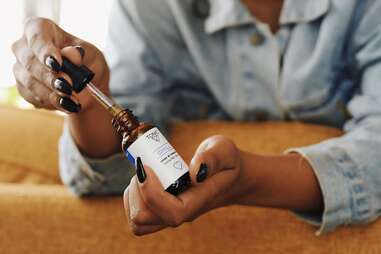How to Spot the Difference Between All These Synthetic Cannabinoids
Delta-8, Delta-9, THC, CBD, real weed…here’s what you need to know.

Over the past couple of years, the cannabis scene has grown in leaps and bounds. New states have legalized cannabis, sure, but there’s something else happening—something that’s accessible almost everywhere: Delta-8 THC. The cannabinoid that’s legally treated like hemp, hits like “weed light” and has likely showed up on a grocery store or gas station counter near you.
We’re not talking about the way CBD feels, mind you. Delta-8 gets you high. First discovered by processors turning hemp material into CBD oil, Delta-8 is created by further extracting the THC from that oil. It doesn’t naturally occur in the plant in large amounts as does Delta-9, which is the dominant cannabinoid we associate with the traditional high of regular weed. (Still with us?) To make things more complicated, now there’s a hemp-derived Delta-9 hitting the scene.
In light of the booming “synthetic cannabinoid” landscape, we’ve broken down Delta-8 and Delta-9 THCs. Here’s what you need to know before you try, what to expect, and how they differ from CBD and classic cannabis. This realm is not regulated by state agencies or the FDA, so all adventures should be as well-informed and from as trustworthy sources as possible (which we’ll mention here, too).
What’s Delta-9 THC?
This cannabinoid is what defines cannabis. Delta-9 THC is most prevalent and most responsible for the high we get from a puff of flower. It’s how the federal government defines cannabis as opposed to hemp, which must contain less than 0.3% Delta-9 THC. (Remember, this realm is not regulated by state agencies or the FDA.) It’s also what we’ve studied in the bulk of cannabis research, demonstrating medical benefits like anti-nausea properties and the potential to inhibit the growth of cancer cells. Depending on one’s body chemistry and the size or potency of the dose, its effect can range from mildly relaxing to intensely intoxicating.

What we know about hemp-derived Delta-9, so far
This method of processing hemp CBD oil to derive concentrations of Delta 8 and Delta 9 is so new that there is still a great deal of research needed to understand them. However, they’re here and they’re happening. Officially it’s legal in Minnesota in the form of edibles and beverages that contain no more than 5 milligrams of hemp-derived THC. One can expect that Delta 9 THC derived from hemp oil will not be as strong as THC directly extracted from flower, and you most likely won’t get the same medicinal effects, either. Some report headaches or a dizzy feeling when trying Delta-8 or Delta-9 products that aren’t made by trustworthy manufacturers.
Nice Hemp Co. has a rare reputation as one of those legit brands thoughtfully sourcing hemp-derived cannabinoids from respected farms like East Fork Cultivars and pressing their own hemp flower rosin and isolating out specific cannabinoids themselves for their Delta-9 gummies and lollipops. Goodekind has also been a trusted brand in the Delta space for a minute.

So what’s the deal with Delta-8 THC?
Delta-8 THC is just one chemical bond different from Delta-9 and about half as potent. Since it’s technically made from hemp, most states classify it as a hemp product, like CBD, and let it be mailed over state lines without requiring involvement of cannabis regulatory agencies. It won’t feel as strong as regular weed, but it certainly does something, and for those in states where cannabis remains illegal, Delta-8 is as close as they can get. Others seek it out because of the enjoyable, mellow buzz all its own.
Nice Hemp Co. has a variety of Delta-8 products as well, and even licensed cannabis brands like WUNDER have chosen to include 2 miligrams Delta-8 in their sparkling cannabis drinks—alongside 2mg THC and 4mg CBD—for a fuller-bodied low dose. You can even smoke Delta-8 via infused joints from Go Easy.

A CBD refresher
Cannabidiol can do a lot, but it can also feel like nothing’s happening. It engages with a totally different receptor in our brains than THC does, tied to our endocannabinoid system, which plays a vital role in regulating body processes like mood, metabolism, how we experience pain, and circadian rhythms. CBD nourishes the endocannabinoid system, helping it to do its job without interruption. So when the average person without chronic diseases takes regular doses of well-sourced CBD, it can produce long-term results like sleeping more soundly and a more regular appetite.
CBD can be derived from cannabis or hemp, and its medicinal properties vary from plant to plant. You’ll know if it was derived from cannabis if it has your state’s official “contains cannabis” symbol somewhere on the package. If you didn’t have to show your ID or were able to order it online and have it delivered from another state, it’s derived from hemp and it may not be as potent as CBD-dominant products you can buy at a dispensary. Depending on the farm and the quality of the plant genetics, hemp-derived CBD can still deliver very desirable effects. TONIC and Otherside Hemp are examples of trusted farms stocking many households in non-legal states with safe, legal CBD pre-rolls and vapes.
Nothing in this article is or should be construed as advice regarding the legal status of the substance(s) or medical advice. You should consult a medical professional regarding matters pertaining to your health before starting any course of medical treatment.
